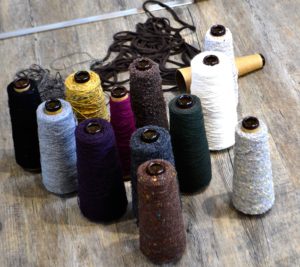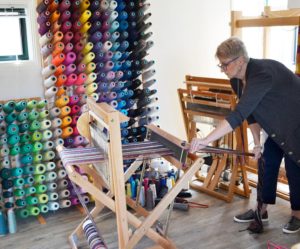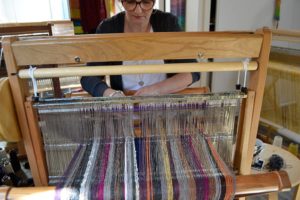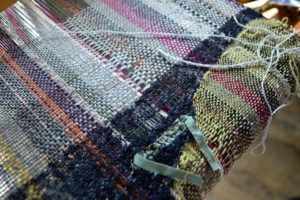
The warping process is a beautiful one! I know some don’t agree with this but it can be very meditative and affirming in a slightly bizarre way. The way the yarns follow each other in a precise path around the warping board pegs, ordered by a cross and creating a design of the imagination but in the process of becoming a physical cloth. The Saori way of purposely using a random selection of yarns keeps our mind attentive to colour and texture too. The absolute order and rhythm of warping creates, I think, a right mind for the weaving ahead. A mind of order and peace. The warping isn’t a free form thing as far as getting those yarns onto the loom in an ordered and even tension for weaving. The Saori set up is more forgiving than others on the loom but you have to have the yarns ordered and thread and sley the loom correctly. There are a few ways to warp up the Saori looms.
 As Saori weaving and what it offers gets around Australia, I’m getting more inquiries from people wanting to push into their own warps, giving them more design independence and choice away from the pre-wounds. Although pre-wounds can be used forever without taking this step, I appreciate that freeing the warping step from the process of weaving itself allows new weavers to really experience and get to know weaving before the more lock step warping. There’s a right time for everything and learning to warp as a first step can put many people off weaving forever!
As Saori weaving and what it offers gets around Australia, I’m getting more inquiries from people wanting to push into their own warps, giving them more design independence and choice away from the pre-wounds. Although pre-wounds can be used forever without taking this step, I appreciate that freeing the warping step from the process of weaving itself allows new weavers to really experience and get to know weaving before the more lock step warping. There’s a right time for everything and learning to warp as a first step can put many people off weaving forever!
 Historically the warp has always been used as an analogy for our lives. The warp is what you are given at birth. It is set on the loom and you have to make the best of it with what you weave into it. Although these types of things seem a little superficial and almost trite today as we are bombarded with so many inspirational sayings, it’s one I like and do feel a connection to. Well I’ll pick up on a weavy one anyway! Don’t worry though, if you begin with a warp that wasn’t beamed or threaded correctly there are rescue ways and even opportunities to discover and learn more about weaving. You just might have to change tack about your original idea. However, it is always good to feel confident in what you are doing with warping and after you finish your first one…you must jump in again.
Historically the warp has always been used as an analogy for our lives. The warp is what you are given at birth. It is set on the loom and you have to make the best of it with what you weave into it. Although these types of things seem a little superficial and almost trite today as we are bombarded with so many inspirational sayings, it’s one I like and do feel a connection to. Well I’ll pick up on a weavy one anyway! Don’t worry though, if you begin with a warp that wasn’t beamed or threaded correctly there are rescue ways and even opportunities to discover and learn more about weaving. You just might have to change tack about your original idea. However, it is always good to feel confident in what you are doing with warping and after you finish your first one…you must jump in again.

I’d like you to see Megan’s recent warping workshop. From her colour palette to the final beaming, threading on the loom. It was a good illustration of just how much the warp colours subtly shade the background of the weaving. The warp colours always combine and affect the weft colours you weave across in this type of weaving. This is because we are weaving to have a drape in our cloth and both warp and weft work together in the design. If you only wanted to see the weft and produce a heavier fabric, such as tapestry, rug or frame loom weaving, the warp is spaced much further apart and the wefts will slip and pack down to cover all of the warp. Conversely, for a fabric where you only see the warp colours, producing very intense colouring potential, the warp is packed so closely together that the weft won’t be seen at all except at the edges where it turns into the next row.

Yes! Beaming can be active. You need to go from the front to the back of the loom to get that warp beamed under even tension (which is the goal). This applies to all floor looms. Special thanks to Megan for filling the studio with warping and weaving.


